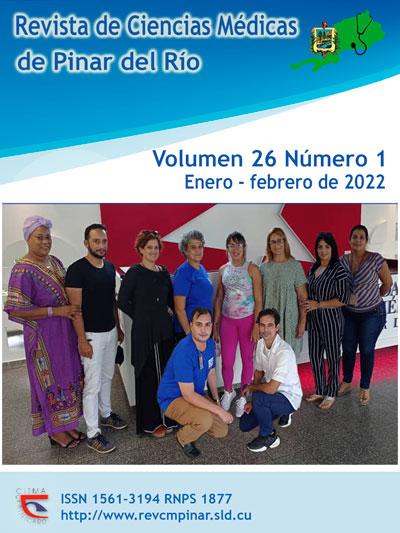GastrOnSoft: educational software on diagnosis and treatment of gastrointestinal tract neoplasms in General Surgery
Keywords:
ABDOMINAL NEOPLASMS, TEACHING, EDUCATIONAL SOFTWARE, SURGERY.Abstract
Introduction: cancers of the digestive tract constitute an important medical burden worldwide due to their high prevalence and mortality. Educational technologies are inherent elements of development in all spheres of life and among them; educational software stands out for the great benefits it brings to the teaching-learning process.
Objective: to develop educational software to favor the teaching of oncological diseases of the digestive tract or system in the subject of General Surgery.
Methods: a technological development research was carried out, which complies with a study in the fourth-academic year of the Medicine major at Mariana Grajales Coello School of Medical Sciences, corresponding to the subjects Neoplasias of the digestive tract of the General Surgery course. The target group comprised all fourth year-academic students, and the sample included those who participated in the research.
Results: educational software was developed as a resource for the learning of the subject of neoplasias of the digestive tract for fourth-academic year students of Medicine major. It is structured by modules: introduction, syllabus, glossary, media library, complements, exercises, games and help, with an attractive and motivating design. Results were obtained regarding the fundamental teaching-learning processes.
Conclusions: the software developed constitutes the fundamental basis for the computerization of the basic teaching-learning processes of Neoplasia of the digestive tract of the General Surgery subject. The development of the software gives a solution to a great extent to the planned problem; its application was assessed as effective.
Downloads
References
1. Cruz DF, Rojas A, Bastidas BE, Orozco-Chamorro CM. Cáncer del tubo digestivo enpacientes jóvenes del departamento delCauca, tipificación clínica. Rev Colomb Cir [Internet]. 2019 [Citado 14/11/2021]; 34(2): 153-62. Disponible en: https://doi.org/10.30944/20117582.109
2. Borráez-Segura BA, Montoya-Botero JA, Meneses Paula A, Abadía M, Pinilla Raúl E, Oliveros R. Esofagectomía en un centro suramericano de tratamiento del cáncer. rev. colomb. cir. [Internet]. 2018 Mar [Citado 14/11/2021]; 33(1): 71-78. Disponible en: http://www.scielo.org.co/scielo.php?script=sci_arttext&pid=S2011-75822018000100071&lng=en.
3. Organización Panamericana de la Salud. Cancer [Internet]. OPS; 2018. [Citado 14/11/2021]. Disponible en: https://www.paho.org/es/temas/cancer
4. OMS. Cáncer [Internet]. Ginebra, Suiza: OMS; 2017 [citado 20/10/2021].
Disponible en: https://www.who.int/topics/cancer/es
5. Abrams JA, Quante M. Adenocarcinoma of the stomach andother gastric tumors. En: Feldman M, Friedman LS, Brandt LJ, editors. Sleisenger and Fordtran’s gastrointestinaland liver disease. 10thed. Philadelphia: Elsevier; 2016.p. 901-20.
6. Cortés A, Bravo LE, Clín Pat, García Luz S, Collazos P. Incidencia, mortalidad y supervivencia por cáncer colorrectal en Cali, Colombia, 1962-2012. Salud pública Méx [Internet]. 2014 Oct [Citado 14/11/2021]; 56(5): 457-464. Disponible en: http://www.scielo.org.mx/scielo.php?script=sci_arttext&pid=S0036-36342014000500013&lng=es.
7. Luna-Abanto J, Rafael-Horna E, Gil-Olivares F. Cáncer colorrectal en adultos jóvenes: características clínico epidemiológicas en la población peruana. Rev. gastroenterol. Perú [Internet]. 2017 Abr [Citado 14/11/2021]; 37(2): 137-141. Disponible en: http://www.scielo.org.pe/scielo.php?script=sci_arttext&pid=S1022-51292017000200005&lng=es
8. Cheung DY, Choi MG. Current advance in small bowel tumors. Clin Endosc [Internet]. 2011 Sep [Citado 14/11/2021]; 44(1): 13-21. Disponible en: https://www.e-ce.org/journal/view.php?number=6345
9. Cabalé Bolaños M, Mendoza Rojena A, Moner del Toro M, Fernández Gámez ME, Mendoza Cabalé AL. Software Educativo de Introducción a la Genética Médica para estudiantes de Enfermería. CCM [Internet]. 2019 [citado 04/11/2021]; 23(2). Disponible en: http://www.revcocmed.sld.cu/index.php/cocmed/article/view/2771
10. Alcívar Castro E, Zambrano Alcívar K, Párraga Zambrano L, Mendoza García K, Zambrano Villegas Y. Software educativo Geogebra. Propuesta de estrategia metodológica para mejorar el aprendizaje de las matemáticas. UCT [Internet]. 2019 [citado 21/11/2021]; 23(95): 59-65. Disponible en:
https://www.uctunexpo.autanabooks.com/index.php/uct/article/view/247/423
11. Criollo Pedro LJ. Las bondades del software libre en el proceso de enseñanza - aprendizaje en la educación media. Rev Interamericana de Investigación, Educación y Pedagogía [Internet]. 2019 [citado 14/11/2021]; 12(2): 140-156. Disponible en:
https://doi.org/10.15332/25005421.5011
12. Hernández Jaime J, Jiménez Galán YI, Rodríguez Flores E. Más allá de los procesos de
enseñanza-aprendizaje tradicionales: construcción de un recurso didáctico digital. RIDE [Internet]. 2020 [citado 20/11/2021]; 10(20). Disponible en:
https://www.ride.org.mx/index.php/RIDE/article/view/62
13. Delgado Rodríguez Y, Delgado Rodríguez Y, Pérez Pérez SM, Rodríguez Polanco M, Escalona Perdomo R. Software educativo de matemática para estudiantes de Vigilancia y Lucha Antivectorial. Rev Ciencias Médicas [Internet]. 2021 [citado: 20/11/2021]; 25(5): e5074. Disponible en: https://revcmpinar.sld.cu/index.php/publicaciones/article/view/5074
14. García Garcés H, Navarro Aguirre L, López Pérez M, Rodríguez Orizondo MF. Tecnologías de la Información y la Comunicación en salud y educación médica. Rev EDUMECENTRO. 2014 [Citado 14/11/2021]; 6(1). Disponible en: http://scielo.sld.cu
/scielo.php?script=sci_arttext&pid=S2077-28742014000100018
15. Soler Sánchez YM, Pérez Rosabal E, López Sánchez MC. Modificación de conocimientos sobre adherencia terapéutica en adultas mayores con cáncer de mama mediante un programa educativo. MEDISAN [Internet]. 2016 Ene [Citado 14/11/2021]; 20(1): 10-15. Disponible en: http://scielo.sld.cu/scielo.php?script=sci_arttext&pid=S1029-30192016000100003&lng=es
Downloads
Published
How to Cite
Issue
Section
License
Authors who have publications with this journal agree to the following terms: Authors will retain their copyrights and grant the journal the right of first publication of their work, which will be publication of their work, which will be simultaneously subject to the Creative Commons Attribution License (CC-BY-NC 4.0) that allows third parties to share the work as long as its author and first publication in this journal are indicated.
Authors may adopt other non-exclusive license agreements for distribution of the published version of the work (e.g.: deposit it in an institutional telematic archive or publish it in a volume). Likewise, and according to the recommendations of the Medical Sciences Editorial (ECIMED), authors must declare in each article their contribution according to the CRediT taxonomy (contributor roles). This taxonomy includes 14 roles, which can be used to represent the tasks typically performed by contributors in scientific academic production. It should be consulted in monograph) whenever initial publication in this journal is indicated. Authors are allowed and encouraged to disseminate their work through the Internet (e.g., in institutional telematic archives or on their web page) before and during the submission process, which may produce interesting exchanges and increase citations of the published work. (See The effect of open access). https://casrai.org/credit/



